Chapter 8: Laboratory Ventilation for Biosafety
Laboratory Chemical (“Fume”) Hoods
Traditional laboratory chemical (or fume) hoods are designed to capture and control chemical vapors and pull them away from the worker. Although the inward flow of air provides protection to the user, chemical hoods do not provide protection for the product (the desired organism being manipulated). Unless a High Efficiency Particulate Air (HEPA) filter is added, chemical hoods do not provide protection against release of viable organisms to the environment. The airflow within a chemical hood is often somewhat turbulent, which can potentially result in exposure of the user to the organisms being used. In short, a chemical hood is not a biological safety cabinet and should not be used for handling and manipulation of pathogenic agents.
Horizontal Laminar Flow Clean Bench
With horizontal laminar flow clean benches, HEPA filtered air flows horizontally across the workspace directly toward the user (see diagram at end of this chapter). These clean benches provide product protection and were originally designed to provide a particulate free environment for manufacture of semiconductor components. Clean benches do provide product protection against microbial contamination, but they do not provide personal protection or environmental protection. In fact, the horizontal flow of air will blow biological agents directly toward the user and into the laboratory. Clean benches are not a biological safety cabinet, and they should not be used with any materials (biological, chemical, or radiological) requiring containment for protection of personnel or the environment. Clean benches are acceptable for tissue culture work only with cell lines considered to represent low risk (BSL-1 agents) to laboratory workers (including immunocompromised individuals who may frequent the lab). Human cell lines and nonhuman primate cell lines are generally considered to be BSL-2 agents and would not be suitable for use in a clean bench.
Biological Safety Cabinets
There are three classes of biological safety cabinets (BSCs), class I, II, and III (see schematic below). All BSCs provide personnel and environmental protection, with Class II and Class III BSCs also providing product protection. Personnel protection is achieved by inward airflow through the front of the cabinet; product protection is achieved by downward HEPA filtered airflow from the top of the cabinet; and environmental protection is achieved by HEPA filtration of exhaust air. Class II BSCs are by far the most common cabinet used in biomedical research laboratories and there are currently no class I or III BSCs in use at the University of Nevada, Reno.
Classes and Types of Biosafety Cabinets
Description of diagram: Biosafety cabinets belong to one of three classes, Class I, Class II, or Class III. Within Class II, cabinets are further broken down by type. Type A cabinets exist as either Type A1 or Type A2. Type B cabinets exist as either Type B1 or Type B2. Type C cabinets only exist as type C1.

Class I BSCs
Class I BSCs are similar to chemical hoods in that inflow air enters the front of that cabinet, flows across the work area, exits at the rear of the cabinet, and is exhausted outdoors. The primary difference is that chemical hoods usually do not have any filtration mechanism to prevent contaminants from being released to the outside (unless a filter or scrubber is added), whereas all air exhausted from a Class I BSC must pass through a HEPA filter before being exhausted outdoors. The inflow of air into a Class I BSC provides personnel protection, and HEPA filtration of the exhaust air provides environmental protection; however, Class I BSCs do not provide product protection. Class I BSCs are suitable for work involving BSL-1, -2, or -3 agents when product protection is not required. Class I BSCs are generally only used to house equipment when release of infectious aerosols is possible.
Class II BSCs
Class II cabinets are designed for personnel, product and environmental protection. All class II BSCs are designed for work involving BSL-1, -2, and -3 organisms. Class II BSCs are divided into type A and B cabinets based on construction, airflow, and exhaust systems (see diagrams at the end of this chapter).
Type A1 BSCs (formerly known as Type A)
Type A1 cabinets have an inward airflow of 75 feet per minute (fpm), and recirculate approximately 70% of discharge air through the supply HEPA filter back to the work zone. Some Type A1 cabinets have potentially contaminated air plenums that are positively pressured. Any breach of the positively pressured plenum or ducting would result in loss of containment and possible release of material. All discharge air is HEPA filtered before it is exhausted, either to the room or through ducting to the outside via a canopy connection that serves to minimize the effect of fluctuations in room airflow on cabinet performance. Recirculation of air within the cabinet and discharge of exhaust air directly to the room preclude the use of Type A1 cabinets for volatile chemicals or volatile radionuclides. Minute quantities of volatile toxic chemicals or radionuclides can be used in the Type A2 BSC if it is exhausted to the outside via a canopy connection.
Type A2 BSCs (formerly known as Type A/B3 or Type B3)
Type A2 cabinets are similar to Type A1 cabinets but have two notable differences. Type A2 BSCs maintain an average face velocity of 100 feet per minute and all exhaust ducts and plenums are maintained under negative pressure. Air from the BSC is exhausted through a HEPA filter and either into the room or through ducting to the outside via a canopy connection. Only when the BSC is ducted to the outside does it meet the requirements of the former Class II, Type B3 BSC. Minute quantities of volatile toxic chemicals or radionuclides can be used in the Type A2 BSC only if it exhausts to the outside via a canopy connection.
Type B1 BSCs
Type B1 cabinets maintain an average face velocity of 100 feet per minute and are designed so that small quantities of carcinogens and volatile radionuclides required for microbiological work can be handled safely. To prevent buildup of these chemicals within the cabinet, downflow air is “split”, with a portion directed to the front of the cabinet and a portion directed to the back of the cabinet where it is exhausted directly through a HEPA filter and to the outside via hard ducting without recirculation within the cabinet. Volatile chemicals should be handled in the direct exhaust (rear) portion of the cabinet to prevent recirculation. Approximately 30% of outgoing air is recirculated as HEPA filtered downflow air. Type B1 cabinets are suitable for BSL-1, -2, or -3 agents treated with volatile toxic chemicals and volatile radionuclides used in microbiological studies if the work is performed in the direct exhaust (rear) portion of the BSC.
Type B2 BSCs
Type B2 cabinets maintain an average face velocity of 100 feet per minute. These cabinets are referred to as “total exhaust cabinets” because all inflow and downflow air passes through the cabinet only once (without any recirculation), and then is directly exhausted through a HEPA filter and to the outside via hard ducting. Because there is no recirculation of air within the cabinet, downflow air must be drawn in from the room (at the top of the cabinet) and then HEPA filtered prior to entering the cabinet. Type B2 cabinets are suitable for BSL-1, -2, or -3 agents treated with volatile toxic chemicals and volatile radionuclides used in microbiological studies. Because there is no recirculation of air within the cabinet, Type B2 cabinets are expensive to operate and should be specified only when required for use of volatile toxic chemicals and volatile radionuclides. Type B2 cabinets do not provide additional biosafety protection over other Class II BSCs.
Class III BSCs
Class III BSCs are of a glove-box design (gas-tight containment) that provides the highest level of personnel protection, as well as product and environmental protection. Both supply and exhaust air are HEPA filtered. These cabinets should be maintained under a minimum negative pressure of 0.5" w.g. Exhaust air is discharged to the outdoors through double HEPA filters (or HEPA and air incineration). Passage of materials into and out of Class III BSCs requires passage through a dunk tank or double door pass-through box that can be decontaminated (e.g., an autoclave). Class III cabinets provide the highest level of containment and can be used for work involving any infectious agent; however, they are most appropriate for work involving BSL- 4 agents.
Certification of BSCs
Commercial BSCs are tested by the cabinet manufacturer in accordance with National Sanitation Foundation (NSF) criteria. Cabinets that meet the NSF criteria for performance characteristics including biological containment, ventilation, cabinet leakage, and HEPA filter leakage are NSF certified. Field certification of BSCs is also required to ensure that the cabinet still performs as it did when it obtained NSF certification at the factory. Field certification is required by the CDC and NIH under the following circumstances: 1) upon installation of a new BSC, 2) annually thereafter, 3) after repair or maintenance is performed, and 4) after the BSC is relocated.
NSF standard 49 provides criteria for construction of BSCs, testing by manufacturers (including biological containment testing), and field certification. NSF has also established a certification program for field certifiers to ensure a minimum level of competency and professionalism. It is recommended that NSF field certifiers be used for field certification of BSCs. Field certification tests include:
- Primary Tests (BSC performance):
- Inflow test
- Downflow test
- Smoke pattern test
- HEPA filter leakage
- Cabinet leakage (when BSC is newly installed, relocated, or maintenance has been performed that involved removal of access panels)
- Additional tests (worker comfort and safety): performed at discretion of certifier
- Noise
- Vibration
- Lighting
- Electrical leakage, polarity, and ground circuit resistance
The university has a sole BSC certification agreement with an approved BSC certifier to ensure the most competitive pricing for certification of BSCs on the University campus. Through this agreement, one annual certification of a BSC is conducted and paid for by the Research and Innovation Office and the EH&S Department. Payment for repair and maintenance of BSCs beyond the annual certification is the responsibility of the individual laboratory or department. This program is coordinated by Cheston Carpenter in EH&S and questions or issues regarding certification of BSCs should be directed to him at chestonc@unr.edu or (775)-784-4342.
Guidelines for Use of Biological Safety Cabinets
The installation and use of a BSC is an indication that safe work practices are needed to prevent contamination and infection. Modern BSCs are extensively engineered and provide excellent containment of microorganisms; however, they are not substitutes for good work practices and can only serve to complement a safe worker. The following are general recommendations for BSC use.
- Ready Work Area
- Turn off UV lamp (if equipped); turn on fluorescent light. UV light can burn eyes and skin so always minimize exposure by turning off the UV light when near the BSC.
- Check air grilles for obstructions; turn on fan (blower).
- Allow air to purge workspace for at least 3 minutes.
- Pre-disinfect
- Spray or swab all interior surfaces with an appropriate disinfectant.
- Allow the surfaces to air dry.
- Assemble Materials
- Only introduce materials that are required to perform the procedure.
- Position materials left to right (or right to left) in the BSC so that clean and contaminated items do not touch. For example, position clean supplies on the left side of the BSC, conduct work with biological agents in the center, and collect contaminated items and waste on the right side of the BSC (see diagram below).
- Ensure the view screen is properly located and secured.
A typical layout for working clean to dirty (left to right) in a BSC

- Pre-Purge Cabinet
- Allow the BSC fan to run for at least three minutes with no activity inside (leave fan on!).
- Prepare Self
- Don protective clothing, gloves, respirator, etc., as appropriate.
- Perform Procedures
- Minimize movement of arms during procedure; move arms straight in or out of the BSC when entering or exiting.
- Work from a clean area to more contaminated work areas (see diagram above). Do not routinely pass items out of the BSC when working in the cabinet.
- Remove gloves into contaminated material container and collect as biohazardous waste. Collect all waste in a biohazardous waste container inside the BSC; do not directly discard waste items outside of the BSC.
- Cleanup and Post-disinfection
- Place potentially contaminated materials in a biohazard bag or other appropriate container.
- Wipe surfaces of all items in the BSC with an appropriate disinfectant.
- After surface decontamination, remove all items from the BSC and autoclave (or otherwise disinfect) waste and other contaminated materials as appropriate.
- Disinfect all interior surfaces of the BSC.
- Personal Hygiene
- Remove protective clothing, respirator, etc., and dispose of as appropriate.
- Wash hands.
- Post-Purge Cabinet
- Allow air purge period (minimum of three minutes) with no activity inside (leave fan on!).
- Shutdown cabinet
- Turn off blower and fluorescent lamp.
- Turn on UV lamp (if equipped).
Horizontal Flow “Clean Bench”
Description of diagram: Room air moves into the top of the clean bench, and into the supply HEPA filter. HEPA-filtered air them moves into the work area of the clean bench, and out the sash opening at the front of the equipment. Some vertical flow clean benches have recirculated air through front and/or rear grilles.
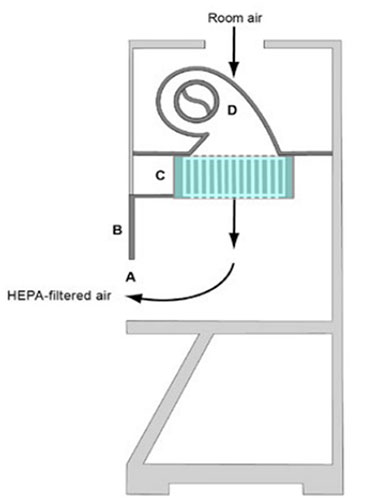
Class I BSC
Description of diagram: Room air moves into the front of the biosafety cabinet through the front opening, under the sash. Air then moves toward the back of the cabinet through the exhaust plenum, while some air recirculates within the working area of the equipment. Air finally moves through an exhaust HEPA filter at the top of the cabinet, which then exhausts the HEPA filtered air into the room.
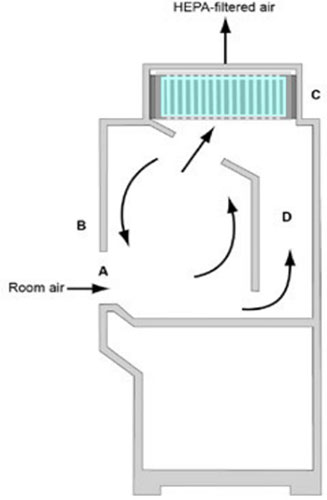
Class II Type A BSC
Can be exhausted to room or to outside via canopy connection.
Description of diagram: Room air moves into the front opening of the biosafety cabinet, under the sash. Air then travels through grilles at the bottom-front and bottom-rear of the work surface, where it travels up the common plenum toward the exhaust blower. Air is then split, with some traveling through a supply HEPA filter into the work area of the cabinet, and some traveling through the exhaust HEPA filter before being exhausted to the room. Since 2010, there is minimal difference between the Class II, Type A1 and the Class II, Type A2, except for the inflow velocity.
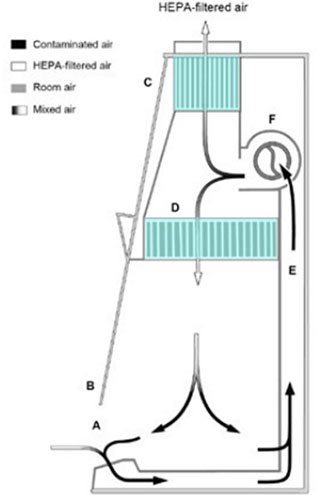
Class II Type B1 BSC
Hard ducted to outside.
Description of diagram: Room air moves into the front of the Class II Type B1 biosafety cabinet through the front opening, under the sash. Some air travels through a negative pressure dedicated exhaust plenum at the rear of the equipment, where it then travels through an exhaust HEPA filter; HEPA filtered air is then exhausted from the cabinet through a direct connection to the building exhaust system. Other air in the working area of the biosafety cabinet travels through a supply HEPA filter, where it is positively pressurized by the blower. Additional HEPA filtration for supply air is provided so that air moving into the working area of the BSC is HEPA-filtered.
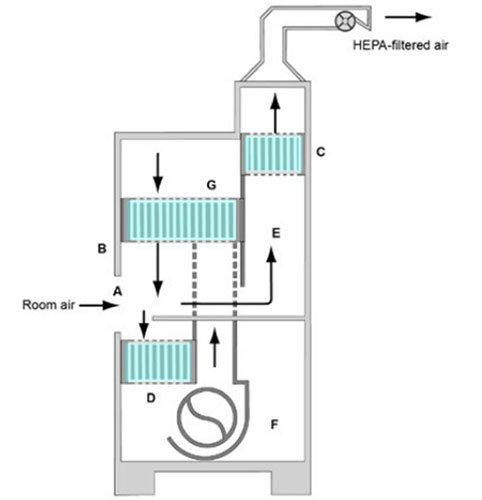
Class II Type B2 BSC
Hard ducted to outside.
Description of diagram: Room air moves into the front of the Class II, Type B2 biosafety cabinet through the front opening, under the sash. Room air also enters the equipment through an opening in the top of the equipment, where it travels through a supply HEPA filter before moving in the working area of the biosafety cabinet. Air in the BSC then travels out of the equipment through a negative pressure exhaust plenum, where it passes through an exhaust HEPA filter before traveling through a direct connection to the building exhaust system.
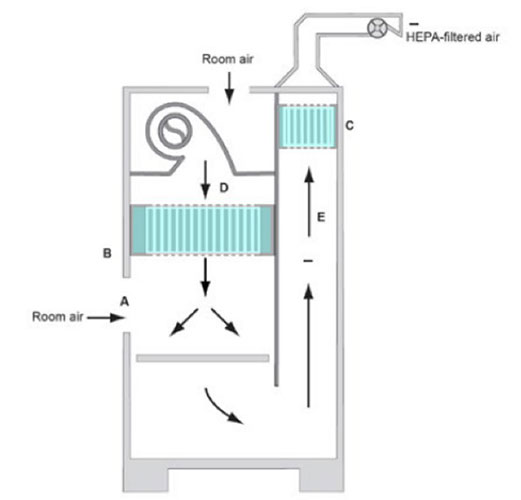
Class II Type C1 BSC
Not connected to building exhaust system.
Description of diagram: Room air moves into the front of the Class II, Type C1 biosafety cabinet through the front opening, under the sash. Air in the working area of the BSC is then split, with some traveling back to a supply blower and supply filter, and other air traveling through an exhaust blower and exhaust HEPA filter. HEPA-filtered air is exhausted directly to the room.
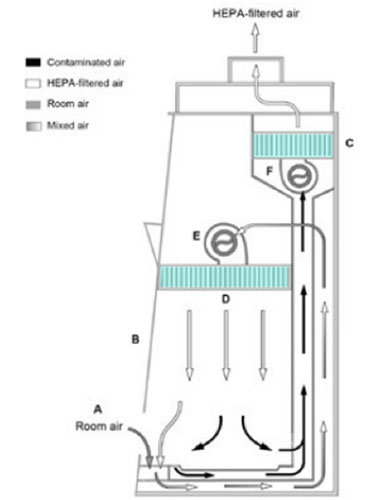
Class II Type C1 BSC
Connected to building exhaust system.
Description of diagram: Room air moves into the front of the Class II, Type C1 biosafety cabinet through the front opening, under the sash. Air in the working area of the BSC is then split, with some traveling back to a supply blower and supply filter, and other air traveling through an exhaust blower and exhaust HEPA filter. HEPA-filtered air is exhausted directly to the room. A canopy opening/gap at the top front of the BSC allows room air to travel into the building exhaust ductwork without having to travel through the BSC. Optional flexible ducting connects the exhaust duct to the facility exhaust system.
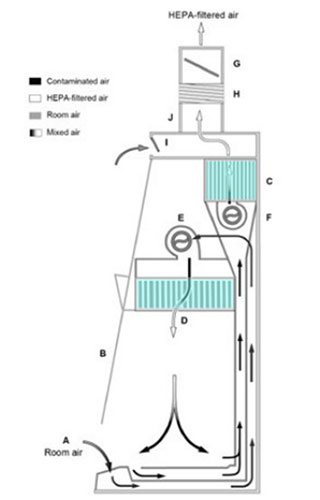
All diagrams adapted from BMBL, 6th edition 2020, Centers for Disease Control.